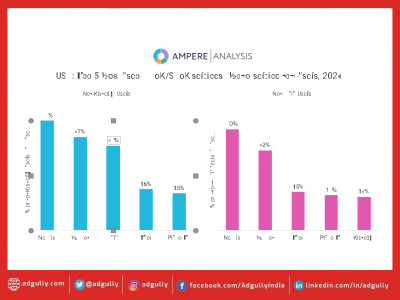Disney+ adds 7.9 million subscribers in Q2
The Walt Disney Company reported earnings for its second fiscal quarter ended April 2, 2022.
- Revenues for the quarter and six months grew 23% and 29%, respectively, despite a $1.0 billion reduction for the amount due to a customer to early terminate license agreements for film and television content delivered in previous years in order for the Company to use the content primarily on our direct-to-consumer services.
- Diluted earnings per share (EPS) from continuing operations for the quarter decreased to $0.26 from $0.50 in the prior-year quarter. Excluding certain items(1), diluted EPS for the quarter increased to $1.08 from $0.79 in the prior-year quarter.
- EPS from continuing operations for the six months ended April 2, 2022 increased to $0.89 from $0.52 in the prior-year period. Excluding certain items(1), EPS for the six months increased to $2.14 from $1.11 in the prior-year period.
“Our strong results in the second quarter, including fantastic performance at our domestic parks and continued growth of our streaming services—with 7.9 million Disney+ subscribers added in the quarter and total subscriptions across all our DTC offerings exceeding 205 million—once again proved that we are in a league of our own,” said Bob Chapek, Chief Executive Officer, The Walt Disney Company. “As we look ahead to Disney’s second century, I am confident we will continue to transform entertainment by combining extraordinary storytelling with innovative technology to create an even larger, more connected, and magical Disney universe for families and fans around the world.”
The Company evaluates the performance of its operating segments based on segment operating income, and management uses total segment operating income as a measure of the performance of operating businesses separate from non-operating factors. The Company believes that information about total segment operating income assists investors by allowing them to evaluate changes in the operating results of the Company’s portfolio of businesses separate from non-operational factors that affect net income, thus providing separate insight into both operations and other factors that affect reported results.
Since early 2020, the world has been, and continues to be, impacted by the novel coronavirus (COVID-19) and its variants. COVID-19 and measures to prevent its spread have impacted our segments in a number of ways, most significantly at the Disney Parks, Experiences and Products segment where our theme parks and resorts were closed and cruise ship sailings and guided tours were suspended. These operations resumed at various points since May 2020, initially at reduced operating capacities as a result of COVID-19 restrictions. In fiscal 2020 and 2021, we delayed, or in some cases, shortened or canceled theatrical releases. In addition, we experienced significant disruptions in the production and availability of content, including the delay of key live sports programming during fiscal 2020 and fiscal 2021.
In fiscal 2022, our domestic parks and resorts are generally operating without significant COVID-19-related capacity restrictions, such as those that were in place in the prior year. Certain of our international parks and resorts and cruise ship operations continue to be impacted by COVID-19-related closures and capacity and travel restrictions. At the Disney Media and Entertainment Distribution segment, our film and television productions have generally resumed, although we have seen disruptions of production activities depending on local circumstances. We have generally been able to release our films theatrically in the first half of fiscal 2022, although certain markets continue to impose restrictions on theater openings and capacity.
We have incurred, and will continue to incur, costs to address government regulations and the safety of our employees, guests and talent, of which certain costs are capitalized and will be amortized over future periods.
Linear Networks revenues for the quarter increased 5% to $7.1 billion, and operating income decreased 1% to $2.8 billion.
Domestic Channels revenues for the quarter increased 8% to $5.8 billion, and operating income increased 3% to $2.3 billion. The increase in operating income was due to higher operating income at Broadcasting, partially offset by lower operating income at Cable.
The increase at Broadcasting was due to higher results at the owned television stations and, to a lesser extent, at ABC. The increase at ABC was due to higher affiliate and advertising revenue, partially offset by higher programming and production costs and an increase in marketing costs. Higher affiliate revenue was due to an increase in contractual rates. The increase in advertising revenue was due to the timing of The Academy Awards and higher rates, partially offset by a decrease in viewership and, to a lesser extent, fewer units delivered. The Academy Awards aired in the current quarter compared to the third quarter in the prior year. Higher programming and production costs were due to the timing of The Academy Awards, partially offset by lower average cost of other programming in the current quarter compared to the prior-year quarter. The increase at the owned television stations was due to higher advertising and affiliate revenue. Advertising revenue growth was due to the timing of The Academy Awards and increased rates. The increase in affiliate revenue was due to higher contractual rates.
The decrease at Cable was due to higher programming and production costs, partially offset by growth in advertising and affiliate revenue. The increase in programming and production costs was due to higher costs for NFL programming, contractual rate increases for College Football Playoff, NBA and college basketball, and an increase in sports production costs. Higher NFL programming costs were due to airing three regular season games, a wild card playoff game and the Pro Bowl in the current quarter compared to a wild card playoff game in the prior-year quarter. The increase in sports production costs was driven by the return of ESPN-hosted college events, which were canceled in the prior-year quarter due to COVID-19. These increases were partially offset by lower costs for MLB programming due to the delayed start of the 2022 MLB season. Advertising revenue growth was due to higher impressions reflecting higher average viewership and, to a lesser extent, an increase in rates. Higher affiliate revenue was driven by an increase in contractual rates, partially offset by fewer subscribers.
International Channels
International Channels revenues for the quarter decreased 3% to $1.3 billion and operating income decreased 30% to $0.2 billion. The decrease in operating income was due to lower affiliate revenue and an increase in programming and production costs, partially offset by advertising revenue growth.
Lower affiliate revenue reflected the impact of channel closures and an unfavorable foreign exchange impact.
Higher programming and production costs were driven by increased costs for cricket programming in the current quarter, partially offset by the impact of channel closures and a favorable foreign exchange impact. Higher costs for cricket programming were due to the airing of ten Indian Premier League (IPL) cricket matches in the current quarter compared to none in the prior-year quarter and contractual rate increases for Board of Control for Cricket in India matches. IPL cricket matches typically occur in our second and third fiscal quarters. As a result of COVID-19, no matches took place in the prior-year quarter.
The increase in advertising revenue was due to higher average viewership driven by the airing of IPL cricket matches in the current quarter, and higher rates, partially offset by an unfavorable foreign exchange impact.
Direct-to-Consumer
Direct-to-Consumer revenues for the quarter increased 23% to $4.9 billion and operating loss increased $0.6 billion to $0.9 billion. The increase in operating loss was due to higher losses at Disney+ and ESPN+ and lower operating income at Hulu.
Lower results at Disney+ reflected higher programming and production, marketing and technology costs, partially offset by an increase in subscription revenue. Higher subscription revenue was due to subscriber growth and increases in retail pricing. The increases in costs and subscribers reflected growth in existing markets and, to a lesser extent, expansion to new markets.
Lower results at ESPN+ were due to higher sports programming costs and a decrease in income from Ultimate Fighting Championship (UFC) pay-per-view events, partially offset by an increase in subscription revenue due to subscriber growth. Lower UFC pay-per-view income was due to a decrease in average buys per event.
The decrease at Hulu was due to higher programming and production, marketing and technology costs, partially offset by subscription revenue growth and higher advertising revenue. The increase in programming and production costs was primarily due to higher subscriber-based fees for programming the Live TV service due to the carriage of more networks, an increase in the number of subscribers and rate increases. Subscription revenue growth was due to an increase in subscribers and higher average rates primarily due to increases in retail pricing. The increase in advertising revenue was due to higher rates and impressions.
The average monthly revenue per paid subscriber for domestic Disney+ increased from $6.01 to $6.32 due to an increase in retail pricing and a lower mix of wholesale subscribers, partially offset by a higher mix of subscribers to multi-product offerings.
The average monthly revenue per paid subscriber for international Disney+ (excluding Disney+ Hotstar) increased from $5.14 to $6.35 due to increases in retail pricing.
The average monthly revenue per paid subscriber for Disney+ Hotstar increased from $0.49 to $0.76 due to launches in new territories with higher average prices and higher per-subscriber advertising revenue, partially offset by a higher mix of wholesale subscribers.
The average monthly revenue per paid subscriber for ESPN+ increased from $4.55 to $4.73 primarily due to an increase in retail pricing and, to a lesser extent, higher per-subscriber advertising revenue, partially offset by a higher mix of subscribers to multi-product offerings.
The average monthly revenue per paid subscriber for the Hulu SVOD Only service increased from $12.08 to $12.77 due to an increase in retail pricing and, to a lesser extent, higher per-subscriber advertising revenue, partially offset by a higher mix of subscribers to multi-product offerings.
The average monthly revenue per paid subscriber for the Hulu Live TV + SVOD service increased from $81.83 to $88.77 due to an increase in retail pricing and higher per-subscriber advertising revenue, partially offset by a higher mix of subscribers to multi-product offerings.
Content Sales/Licensing and Other
Content Sales/Licensing and Other revenues for the quarter decreased 3% to $1.9 billion and segment operating income decreased to $16 million from $312 million. The decrease in operating income was due to lower TV/SVOD distribution results and, to a lesser extent, a decrease at home entertainment due to lower sales of catalog titles in the current quarter.
The decrease in TV/SVOD distribution results was due to a decrease in sales of episodic television content driven by higher sales of Modern Family and How I Met Your Mother in the prior-year quarter.
Disney Parks, Experiences and Products
Disney Parks, Experiences and Products revenues for the quarter increased to $6.7 billion compared to $3.2 billion in the prior-year quarter. Segment operating results increased by $2.2 billion to income of $1.8 billion compared to a loss of $0.4 billion in the prior-year quarter. Higher operating results for the quarter reflected increases at our domestic parks and experiences businesses and, to a lesser extent, at our international parks and resorts and merchandise licensing businesses.
Operating income growth at our domestic parks and experiences was due to higher volumes and increased guest spending, partially offset by higher costs. Higher volumes were due to increases in attendance, occupied room nights and cruise ship sailings. Cruise ships operated at reduced capacities in the current quarter while sailings were suspended in the prior-year quarter. Guest spending growth was due to an increase in average per capita ticket revenue, higher average daily hotel room rates and an increase in food, beverage and merchandise spending. The increase in average per capita ticket revenue was due to a favorable attendance mix and the introduction of Genie+ and Lightning Lane in the first quarter of the current fiscal year. Higher costs were primarily due to volume growth, cost inflation and higher marketing spending. Our domestic parks and resorts were open for the entire current quarter, whereas Disneyland Resort was closed for all of the prior-year quarter, and Walt Disney World Resort operated at reduced capacity in the prior-year quarter due to COVID-19 restrictions.
Improved results at our international parks and resorts was due to growth at Disneyland Paris, partially offset by decreases at Hong Kong Disneyland Resort and Shanghai Disney Resort. Higher operating results at Disneyland Paris were due to increases in attendance and occupied room nights, partially offset by higher operating costs due to volume growth and increased marketing costs. The decreases at Hong Kong Disneyland Resort and Shanghai Disney Resort were driven by lower attendance. Disneyland Paris was open for the entire current quarter and closed for all of the prior-year quarter. Hong Kong Disneyland Resort was open for 3 days in the current quarter compared to 33 days in the prior-year quarter. Shanghai Disney Resort was open for 78 days in the current quarter and open for all of the prior-year quarter. Tokyo Disney Resort was open for the entire quarter in both the current and prior years.
Growth in merchandise licensing was driven by higher sales of merchandise based on Mickey and Minnie, Spider-Man, Star Wars Classic and Disney Princesses, partially offset by lower minimum guarantee shortfall recognition.
Corporate and unallocated shared expenses increased $71 million for the quarter, from $201 million to $272 million, driven by the timing of allocations to operating segments.
In the current quarter, the Company recorded charges totaling $195 million due to the impairment of an intangible asset related to the Disney Channel in Russia. During the prior-year quarter, the Company recorded charges totaling $414 million due to asset impairments and severance costs related to the planned closure of an animation studio and a substantial number of our Disney-branded retail stores as well as severance at our parks and resorts businesses.
In the current quarter, the Company recorded a $158 million non-cash loss to adjust its investment in DraftKings, Inc. (DraftKings) to fair value (DraftKings loss). In the prior-year quarter, the Company recorded a $305 million gain on DraftKings.
The decrease in interest expense was primarily due to lower average debt balances and higher capitalized interest.
The decrease in interest income, investment income and other was due to investment losses in the current quarter compared to investment gains in the prior-year quarter. This decrease was partially offset by a favorable comparison of pension and postretirement benefit costs, other than service cost, which was a net benefit in the current quarter and an expense in the prior-year quarter.
The effective income tax rate in the current quarter was higher than the U.S. statutory rate primarily due to higher effective tax rates on foreign earnings, including the impact of tax regulations issued in the current quarter that limit our ability to utilize certain foreign tax credits. The effective income tax rate in the prior-year quarter was lower than the U.S. statutory rate due to the favorable resolution of various tax matters and excess tax benefits on employee share-based awards, partially offset by higher effective tax rates on foreign earnings. Higher effective tax rates on foreign earnings in both the current and prior-year quarters reflected the impact of foreign losses and foreign tax credits for which we are unable to recognize a tax benefit.
The decrease in net income from continuing operations attributable to noncontrolling interests was driven by higher losses at our DTC sports business. Net income attributable to noncontrolling interests is determined on income after royalties and management fees, financing costs and income taxes, as applicable.
Cash provided by operations for fiscal 2022 increased by $0.1 billion from $1.5 billion in the prior-year period to $1.6 billion in the current period. The increase was due to higher operating income and lower severance payments, partially offset by higher spending for film and television content and a partial payment for the Content License Early Termination.
Capital expenditures increased from $1.5 billion to $2.1 billion due to higher spending at Disney Parks, Experiences and Products in the current period on cruise ship expansion and new guest offerings, in part reflecting the impact from the temporary suspension of certain capital projects in the prior year as a result of COVID-19. The increase also reflected higher spending on corporate facilities.
In the U.S., Disney+, ESPN+ and Hulu SVOD Only are each offered as a standalone service or as a package that includes all three services (the SVOD Bundle). Effective December 21, 2021, Hulu Live TV + SVOD includes Disney+ and ESPN+ (the new Hulu Live TV + SVOD offering), whereas previously, Hulu Live TV + SVOD was offered as a standalone service or with Disney+ and ESPN+ as optional additions (the old Hulu Live TV + SVOD offering). Effective March 15, 2022, Hulu SVOD Only is also offered with Disney+ as an optional add-on. Disney+ is available in more than 80 countries and territories outside the U.S. and Canada. In India and certain other Southeast Asian countries, the service is branded Disney+ Hotstar. In certain Latin American countries, we offer Disney+ as well as Star+, a general entertainment SVOD service, which is available on a standalone basis or together with Disney+ (Combo+). Depending on the market, our services can be purchased on our websites, through third-party platforms/apps or via wholesale arrangements.
Paid subscribers reflect subscribers for which we recognized subscription revenue. Subscribers cease to be a paid subscriber as of their effective cancellation date or as a result of a failed payment method. Subscribers to the SVOD Bundle are counted as a paid subscriber for each service included in the SVOD Bundle and subscribers to the Hulu Live TV + SVOD offerings are counted as one paid subscriber for each of the Hulu Live TV + SVOD, Disney+ and ESPN+ offerings. If a Hulu SVOD Only subscriber chooses to add on Disney+, they are counted as one paid subscriber for each of the Hulu SVOD Only and Disney+ offerings. In Latin America, if a subscriber has either the standalone Disney+ or Star+ service or Combo+, they are counted as one Disney+ paid subscriber. Subscribers include those who receive a service through wholesale arrangements including those for which we receive a fee for the distribution of the service to each subscriber of an existing content distribution tier. When we aggregate the total number of paid subscribers across our DTC streaming services, we refer to them as paid subscriptions.
Revenue per paid subscriber is calculated based on the average of the monthly average paid subscribers for each month in the period. The monthly average paid subscribers is calculated as the sum of the beginning of the month and end of the month paid subscriber count, divided by two. Disney+ average monthly revenue per paid subscriber is calculated using a daily average of paid subscribers for the period. Revenue includes subscription fees, advertising (excluding revenue earned from selling advertising spots to other Company businesses) and premium and feature add-on revenue but excludes Premier Access and Pay-Per-View revenue. The average revenue per paid subscriber is net of discounts on the SVOD Bundle or other offerings that carry more than one service. Revenue is allocated to each service based on the relative retail price of each service on a standalone basis. Starting in December 2021, revenue for the new Hulu Live TV + SVOD offering is allocated to the SVOD services based on the wholesale price of the SVOD Bundle. In general, wholesale arrangements have a lower average monthly revenue per paid subscriber than subscribers that we acquire directly or through third-party platforms.
NON-GAAP FINANCIAL MEASURES
This earnings release presents free cash flow, diluted EPS excluding certain items, and total segment operating income, all of which are important financial measures for the Company, but are not financial measures defined by GAAP.
These measures should be reviewed in conjunction with the most comparable GAAP financial measures and are not presented as alternative measures of cash provided by continuing operations, diluted EPS or income from continuing operations before income taxes as determined in accordance with GAAP. Free cash flow, diluted EPS excluding certain items and total segment operating income as we have calculated them may not be comparable to similarly titled measures reported by other companies.
The Company uses free cash flow (cash provided by continuing operations less investments in parks, resorts and other property), among other measures, to evaluate the ability of its operations to generate cash that is available for purposes other than capital expenditures. Management believes that information about free cash flow provides investors with an important perspective on the cash available to service debt obligations, make strategic acquisitions and investments and pay dividends or repurchase shares.
The Company uses diluted EPS excluding (1) certain items affecting comparability of results from period to period and (2) amortization of TFCF and Hulu intangible assets, including purchase accounting step-up adjustments for released content, to facilitate the evaluation of the performance of the Company’s operations exclusive of these items, and these adjustments reflect how senior management is evaluating segment performance.
The Company believes that providing diluted EPS exclusive of certain items impacting comparability is useful to investors, particularly where the impact of the excluded items is significant in relation to reported earnings and because the measure allows for comparability between periods of the operating performance of the Company’s business and allows investors to evaluate the impact of these items separately.
The Company further believes that providing diluted EPS exclusive of amortization of TFCF and Hulu intangible assets associated with the acquisition in 2019 is useful to investors because the TFCF and Hulu acquisition was considerably larger than the Company’s historic acquisitions with a significantly greater acquisition accounting impact.
















Share
Facebook
YouTube
Tweet
Twitter
LinkedIn